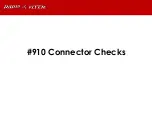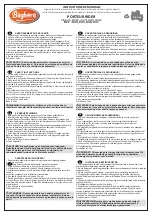
13
the “Play” button on the remote control, item 8402, or by placing a vehicle ready to drive in front of it and starting it.
4.5.3 Switch-off command for following vehicles
When you switch off a vehicle, all other vehicles in the same lane will be switched off as well, as this command is “passed
through to the rear”.
In the CarManager it is configurable if the vehicles switch-off as described or if they merely wait as described under 4.5.2.
5. Vehicle configuration and control with IR remote control
The infrared sensors in the front of the vehicle (adaptive cruise control) can also be used to receive commands from a remote
control (item 8402). You can switch the basic functions and change the speed without having to connect the vehicle to its
programming device. For detailed description of the functions of the remote control, please refer to its own user manual.
6. Vehicle configuration via the CarManager software
The CarManager software is a PC application providing configuration and update possibilities for your vehicles (fig. 12).
You may also check the charge level of your battery as well as read the vehicle’s software version. To configure or update
a vehicle you will need to connect the vehicle to a PC with the help of a programming device. The programming device
(item 8401) has a 2x3 pin plug that has to be connected to the socket hidden under the fuel tank, just as the charger (fig. 5).
However, the programming device does not work in both plugging directions. Therefore, plug it in direction away from the
vehicle (fig. 5). If the vehicle does not switch on when the plug is plugged, you need to switch it on yourself.
Note:
The latest version of the CarManager software can always be downloaded from the website www.viessmann-modell.de.
7. Maintenance and checks
CarMotion vehicles are detailed reproductions of reality. The structure of these vehicles requires some care at regular intervals to
ensure that you will have as much fun as possible with the vehicles and their functions, for as long as possible.
7.1 Cleaning
From time to time, dust and lint deposits must be removed from the axles, and from drive and steering elements of the
vehicles. Model roads too, should always be kept free of dust and tyre particles. Clean the vehicles using a soft dry cloth and
a soft dry paintbrush, or by softly blowing them with air. Never use water or aggressive detergents.
7.2 Adjusting the steering arm
CarMotion Vehicles can be optimally driven only if the steering arm is adjusted correctly. This is the case in the delivered
condition, however, readjustment may become necessary due to variations that may occur for example through accidents in
traffic. The steering arm should always glide parallel to the surface of the road. Special attention must be paid to the height
of the magnetic arm. If it is too close to the road surface, it may grind on it, thus leaving unwanted scratch marks on the road
and slowly but steadily eroding the arm. If, on the other hand, the arm is too far from the road surface you may encounter
steering problems. The illustration in fig. 13.2 shows the ideal setting.
Note:
- The steering arm must not be screwed on too tightly.
- The steering arm must be positioned just above the roadway and be able to swivel smoothly to the right and to the left.
To check whether the steering slider is correctly adjusted, place the vehicle onto a perfectly flat surface, for instance a glass
pane. It may also be helpful to use a piece of road with magnet tape resp. steel wire as the magnetic forces have an effect
on the position of the arm. Slight grinding as shown in fig. 13.1 can be required for roads with steel wire guidance.
7.3 Changing tyres
Depending on the mileage of the vehicle, it may become necessary to change tyres (fig. 14) at regular intervals. Worn tyres
lead to traction loss and steering problems. This will be particularly noticeable in curves and slopes. Therefore, check tyres
every now and then!
7.4 Replacing the motor
The motors have an expected lifespan of min. 300 hours at normal operation and at least 300 hours at max. speed/full load.
Running at lower speeds will increase the lifespan. Changing the motor can be done as follows:
- First remove the dumper and then lift the plastic cover (fig. 15a).
- The use of a magnetic PH00 screwdriver is required to disassemble the 2 screws that secure the motor holder to the
PCB (fig. 15b).
- Desolder the 2 wires of the motor and make sure to resolder the wires of the new motor in the same way (fig. 15c).
- After having completed the change, the user may reset the motor lifespan counter in the vehicle with the help of the
CarManager software, so that they can keep track of the next scheduled change. After replacing the motor, the magnetic
sensor has to be recalibrated. This can be done with the help of the CarManager.






































